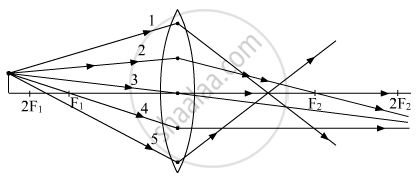Advertisements
Advertisements
Question
Describe the nature of image formed when an object is placed at a distance of 30 cm from a convex lens of focal length 15 cm.
Solution
Given:
u = -30 cm
(Since the object is placed on the left side of lens)
Focal length f = +15 cm
According to lens formula:
`1/v-1/u=1/f`
or `1/v=1/f+1/u`
=`1/15+(-1/30)`
or v=30 cm
Thus, the image is formed at a distance of 30 cm from the convex lens. The plus sign for image distance shows that the image is formed on the right side of the convex lens. Only real and inverted image is formed on the right side of a convex lens; therefore, the image is real and inverted.
APPEARS IN
RELATED QUESTIONS
A student is using a convex lens of focal length 18 cm to study the image formation by it for the various positions of the object. He observes that when he places the object at 27 cm, the location of the image is at 54 cm on the other side of the lens. Identify from the following diagram the three rays that are obeying the laws of refraction and may be used to draw the corresponding ray diagram.

(A) 1, 2 and 4
(B) 1, 3 and 5
(C) 2, 4 and 5
(D) 2, 3 and 4
"A convex lens can form a magnified erect as well as magnified inverted image of an object placed in front of it." Draw ray diagram to justify this statement stating the position of the object with respect to the lens in each case.
Where should an object be placed so that a real and inverted image of the same size as the object is obtained using a convex lens?
Where should an object be placed in front of a convex lens so as to obtain its real, inverted and magnified image?
In order to obtain a real image twice the size of the object with a convex lens of focal length 15 cm, the object distance should be:
(a) more than 5 cm but less than 10 cm
(b) more than 10 cm but less than 15 cm
(c) more than 15 cm but less than 30 cm
(d) more than 30 cm but less than 60 cm
What kind of lens can form:
an erect magnified image?
A light ray does not bend at the boundary in passing from one medium to the other medium if the angle of incident is:
Out of the five incident rays shown in the figure find the three rays that are obeying the laws of refraction and may be used for locating the position of image formed by a convex lens:
(A) 1, 2 and 3
(B) 2, 3 and 4
(C) 3, 4 and 5
(D) 1, 2 and 4

i. Which type of microscope has the arrangement of lenses shown in the adjoining figure?
ii. Label the figure correctly.
iii. Write the working of this microscope.
iv. Where does this microscope used?
v. Suggest a way to increase the efficiency of this microscope.
How will you determine the focal length of a convex lens by the plane mirror method?
